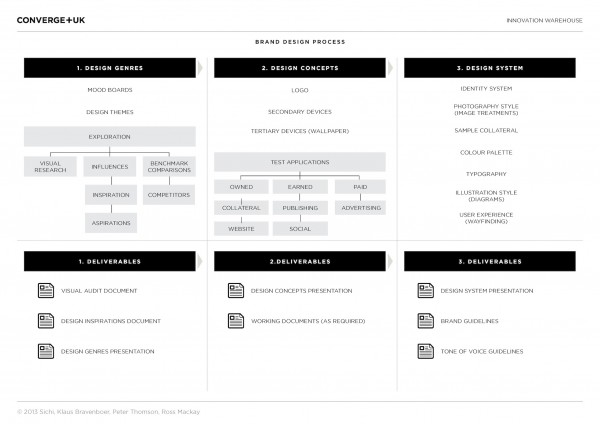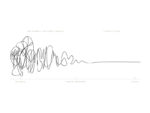Creating a new brand identity can be a chaotic experience. Having a robust design process makes it easier to keep moving when the going gets tough.

Some clients are easy to create a brand for because they already know who they want to target and what they want to say. But most clients have a surprisingly high degree of uncertainty about their strategy, messaging and design. We use lean branding to iterate and improve the brand as we go, but we still need a critical path design process to help us stay focused.
In my work with Better by Design, I was exposed to user centred design processes from both brand designers and industrial designers. We worked with IDEO, DesignWorks, Interbrand, FormWay and other leading design firms. It was interesting to contrast new product development processes with brand design processes. My experience is that the heart of a good brand design process is providing space to support exploration and creativity (while still driving towards a commercial outcome).
Later on, when I worked at BRR, we evolved a design process specifically to deliver good quality brand identities in situations of high uncertainty. I specialised in creating brands for complex clients such as geographical regions, B2B companies and primary producer cooperatives. Personally, I’m a venture capital lawyer by background and a strategist by trade so my role in the design process is to champion user-centred thinking and make sure that the client is happy.
Why have a formal process for a creative undertaking?
Ironically, the more creative the work is, the more systematic the process needs to be. Marissa Mayer (of Google and Yahoo) says that “creativity loves constraints“. Our current design process is designed to account for a high level of uncertainty in startups and technology companies.

If you had a design-aware leader like Steve Jobs as a client, you could just go and show Steve different versions every day and each round of feedback would iterate towards something amazing. But when you have to present to a client team that has a mix of different opinions (from different managers), you need a process to corral opinions and drive towards certainty.
The design process is partially about doing the design, but it’s really about selling the design to the client. Ultimately, the client has to love the brand because they have to live with it. The main deliverable of the brand design isn’t the logo. The real outcome is a design system that can be used to create finished pieces of collateral.
Diverging and converging
Each design stage diverges from a single point. We put a stake in the ground and explore out in multiple directions. The skillsets for diverging and converging are markedly different. At some point during each stage we sit down as a team and decide that we’ve explored wide enough. Then we start to coagulate the work into clusters for presentation to the client as options.

Each stage needs an identifiable deliverable that shows progress. We need to be able to declare that the work is “finished work”, even though it’s just a way-point in the overall process. That allows the means that the client can give intelligent feedback (at the right moment) to guide the end result.
The Lean Brand Design process
The work for the Innovation Warehouse includes a co-operative between myself, Klaus Bravenboer, Sichi, Ross Mackay and other designers. So we’re using a simplified process with can bring together a diverse team.

Here’s the stages in the lean brand design process that we used…
1. Design Genres
The first stage in a good design process is to create a set of design genres. The design genres are a set of ideas and themes that make the brand values and positioning visual. The design genres explore how the strategy comes to life as design, photography and imagery.
The deliverable of this stage is mood boards of found images and examples of existing brands that express a similar tone or “mood”. We built the mood boards using Pinterest boards for internal team collaboration and then made separate collages to represent each of the three proposed design genres.
The design genre document also includes the design team’s interpretations and summary of the key points from the strategy stage. This is usually done by picking out the key bits of copywriting that will be used in the visualisations.
The design genres stage is how a brand moves from fuzzy concepts (in the strategy stage) into visual metaphors, tones, colours, shapes and imagery. It’s best not to do any conventional “design” work at this stage and instead to use found imagery and other brands to convey the options for the tone of the brand.

For the Innovation Warehouse project, we created three design genres based on their brand essence of “serious business innovation”. The themes included mood boards, imagery and exploration:
- The first genre took its cue from mathematics and was inspired by Alan Turing and the calculus of growth.
- The second design genre took its cue from biological models of growth.
- The third design genre expressed the brand essence through fractal mathematics and the scientific models of chaos and order.
The review process for the design genres stage is to present the genres to the client in a review meeting. At the review meeting we ask for:
- Three things that each person likes about each option.
- Three things that each person dislikes about each option.
- We also ask for the attendees to vote on the preferred direction to proceed with to the next round of design.
It’s important that the design review meeting not get hung up on the particular details of each design genre. At this early stage, the genres are simply an attempt to define the playing field within which the creativity of the design process will happen.
2. Design Concepts
The design concepts are explorations based on the chosen design genre and feedback collected in the design genre stage. This is where the real craft of a brand designer kicks in.

The old way of doing brand design was to create design concepts by designing the logo, secondary graphic devices, typography and colour palette in sequence. Usually starting with the the logo by itself.
The Lean Branding approach is to imagine the applications themselves and then birth the design system out of the intended applications. The entire brand is created all at once and then gradually improved as it is tested and iterated. This requires a particular type of experience and creativity. I’ve only worked with a handful of designers in my career who can do this type of “application first” brand design. They’re rare, but worth it.
The deliverables from the design concepts stage are options for the logo, fonts and colour palette as a “minimum viable design system“. The design concept stage usually includes three different design directions for a logo (as well as the associated design system that would go with each logo).
The design concepts stage is really an iterative process within the team. The document is a summary of the team’s thinking up to that point. The design concepts document is a slightly arbitrary milestone at which to get client feedback on two or three options that might survive to become the final design system.
3. Design System
The design system is built using the roughly formed systems that were latent in the design concepts. At this stage, it’s more about converging on a final result. The presentation document will include lots of example applications and they’ll usually be applied to real-world collateral. They’re still not finished design templates. But they set out a single system in a coherent and consistent way.

Once the design system is agreed, the brand guidelines, templates and digital assets are created as a package for use by the client and their in-house design team. The Lean Branding process often involves making iterative improvements to the client’s collateral so the design system can act as an interim brand guidelines until the brand has stabilised enough to be collected into templates and guidelines. (Hint: Never move from Design System stage into final Brand Guidelines until the brand has been applied to at least two real-world pieces of collateral.)
Sometimes, the original brand design team will create some finished collateral items such as posters, t-shirts and other branded items. These are useful as reference samples for the in-house team to use to guide future implementations. These are a key part of lean branding because they allow the team to observe real world users interacting with the brand.
When to do mockups?
Some designers wait until as late as possible in the design process before creating mockups. Whereas, our design process includes mockups as early as possible. As we go through the design stages we get progressively more detailed in how we mock up the work:
- At the design genres stage, it may be a couple of obvious applications like business cards. These will be pretty rough.
- As we move further along into design concepts, we test the work on posters, web, social media and brochures.
- When we get to the design system it will be much more integrated and in-depth and look closer to finished work.
The trick with mockups is to be pragmatic and show just enough so that the brand feels real enough for the client to make an informed decision. For each client, there will be different usages which feel more real based on their industry. For example, with the Innovation Warehouse, the website is very important, as is the interior signage.
One of the risks with normal in-situ applications is that they become too literal and a client will start arguing about the literal application too early in the process and they get distracted from having the timely conversation about the work at hand.
It can be useful to do a deliberately fictional application because it allows you to have a safe conversation. One of the most successful test applications that I’ve used was a mock-up of a retail brand onto a Volkswagen Mini. This was a powerful way of bringing the brand to life even though they would rarely (if ever) actually make car signage.
There are some mockup tools that are deliberately realistic whereas other tools deliberately look unfinished (like a pencil sketch). The reason for making things look deliberately sketched is that the client can get attached to a specific look too early (when it’s more about the overall look). Even so, the sooner we know what the client doesn’t like, the better. On balance, we prefer to show things as realistically as possible so tools like Context by LiveSurface and PlaceIt from Breezi are a key part of our workflow.
You can follow the designs while they are created and tested as a live brand case study and also on the Innovation Warehouse blog. The next step in the process is the design genres. We’ll be uploading the entire document as a PDF so that you can see the work and use it as a template for creating your own brand as well.






